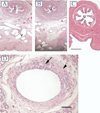Collagen remodeling and suburethral inflammation might account for preserved anti-incontinence effects of cut polypropylene sling in rat model
- PMID: 18829083
- PMCID: PMC4160051
- DOI: 10.1016/j.urology.2008.07.033
Collagen remodeling and suburethral inflammation might account for preserved anti-incontinence effects of cut polypropylene sling in rat model
Abstract
Objectives: To determine whether the inflammatory responses or collagen remodeling in suburethral tissue could have contributed to the preserved anti-incontinence effects of a cut polypropylene sling.
Methods: Stress urinary incontinence was created in 60 age-matched female Sprague-Dawley rats that were subsequently randomized into 3 equal-size groups according to surgical procedure: placement of a vaginal suburethral sling, placement of a vaginal suburethral sling in which the suburethral portion of the sling was immediately cut, and sham surgery without placement of the sling. In a previous study, the leak point pressure measurements were obtained on these rats 6 weeks after surgery. The rats were then killed, the urethrovaginal tissue was harvested (cross-section of the entire urethra and anterior vagina) from 30 animals (10 from each experimental group), and the tissue was stained with hematoxylin-eosin and Masson's trichrome for histopathologic studies and picrosirius red for collagen fibers.
Results: As previously published, the median leak point pressures were similarly and significantly increased in the rats in the intact and cut sling groups compared with those in the sham surgery group. The inflammatory mediators and interstitial edema were similarly increased in the intact and cut sling specimens compared with the sham surgery specimens. Under polarized light, picrosirius red-stained specimens from the sham surgery animals appeared to be composed of collagen that predominately birefringed red to yellow (typical of type I collagen). The picrosirius red-stained cut and intact sling specimens appeared to contain collagen fibers that predominately birefringed green (typical of type III collagen).
Conclusions: Histologic changes, including inflammation, localized edema, and differential collagen remodeling, might contribute to the preserved anti-incontinence mechanisms of cut or intact polypropylene slings observed clinically.
Figures



Similar articles
-
Comparison of 2 single incision slings on the vagina in an ovine model.Am J Obstet Gynecol. 2021 Jan;224(1):78.e1-78.e7. doi: 10.1016/j.ajog.2020.07.005. Epub 2020 Jul 21. Am J Obstet Gynecol. 2021. PMID: 32707267
-
Role of sling integrity in the restoration of leak point pressure in the rat vaginal sling model.J Urol. 2005 Aug;174(2):771-5. doi: 10.1097/01.ju.0000164721.52278.29. J Urol. 2005. PMID: 16006974
-
Traditional suburethral sling operations for urinary incontinence in women.Cochrane Database Syst Rev. 2020 Jan 28;1(1):CD001754. doi: 10.1002/14651858.CD001754.pub5. Cochrane Database Syst Rev. 2020. PMID: 31990055 Free PMC article.
-
A tissue-engineered suburethral sling in an animal model of stress urinary incontinence.BJU Int. 2005 Sep;96(4):664-9. doi: 10.1111/j.1464-410X.2005.05702.x. BJU Int. 2005. PMID: 16104928
-
Comparing the vaginal wall sling with autologous rectus fascia and polypropylene sling: Short term outcomes and patient satisfaction.Eur J Obstet Gynecol Reprod Biol. 2018 Dec;231:98-103. doi: 10.1016/j.ejogrb.2018.10.012. Epub 2018 Oct 11. Eur J Obstet Gynecol Reprod Biol. 2018. PMID: 30340120 Review.
Cited by
-
Bone marrow stem cells secretome accelerates simulated birth trauma-induced stress urinary incontinence recovery in rats.Aging (Albany NY). 2021 Mar 31;13(7):10517-10534. doi: 10.18632/aging.202812. Epub 2021 Mar 31. Aging (Albany NY). 2021. PMID: 33793419 Free PMC article.
-
Urethral striated muscle and extracellular matrix morphological characteristics among mildly diabetic pregnant rats: translational approach.Int Urogynecol J. 2014 Mar;25(3):403-15. doi: 10.1007/s00192-013-2218-4. Epub 2013 Sep 17. Int Urogynecol J. 2014. PMID: 24043129
-
Animal models of stress urinary incontinence.Handb Exp Pharmacol. 2011;(202):45-67. doi: 10.1007/978-3-642-16499-6_3. Handb Exp Pharmacol. 2011. PMID: 21290221 Free PMC article. Review.
-
Pathology of urethral fibromuscular system related to parturition-induced stress urinary incontinence and TGF-β1/Smad pathway.Mol Cell Biochem. 2012 May;364(1-2):329-35. doi: 10.1007/s11010-012-1234-x. Epub 2012 Feb 4. Mol Cell Biochem. 2012. PMID: 22307744
-
Mild diabetes models and their maternal-fetal repercussions.J Diabetes Res. 2013;2013:473575. doi: 10.1155/2013/473575. Epub 2013 Jun 26. J Diabetes Res. 2013. PMID: 23878822 Free PMC article. Review.
References
-
- Brown JS, Waetjen LE, Subak LL, et al. Pelvic organ prolapse surgery in the United States, 1997. Am J Obstet Gynecol. 2002;186:712–716. - PubMed
-
- Kim HL, Gerber GS, Patel RV, et al. Practice patterns in the treatment of female urinary incontinence: A postal and Internet survey. Urology. 2001;57:45–48. - PubMed
-
- Leach GE, Dmochowski RR, Appell RA, et al. for the American Urological Association. Female Stress Urinary Incontinence Clinical Guidelines Panel summary report on surgical management of female stress urinary incontinence. J Urol. 1997;158:875–880. - PubMed
-
- Richter HE, Varner RE, Sanders E, et al. Effects of pubovaginal sling procedure on patients with urethral hypermobility and intrinsic sphincteric deficiency: Would they do it again? Am J Obstet Gynecol. 2001;184:14–19. - PubMed
-
- Goldman HB. Simple sling incision for the treatment of iatrogenic urethral obstruction. Urology. 2003;62:714–718. - PubMed
Publication types
MeSH terms
Substances
Grants and funding
LinkOut - more resources
Full Text Sources
Medical
Research Materials

